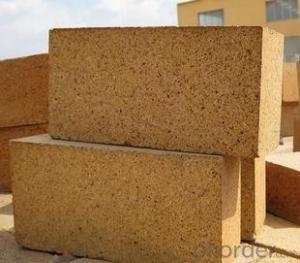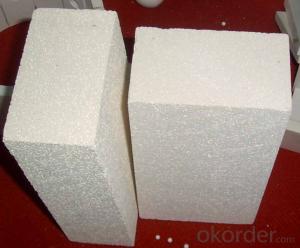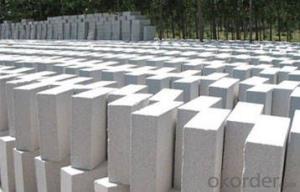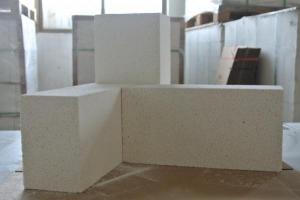Insulating Fire Brick - Refractory Mullite Insulating Refractory Brick JM 92
- Loading Port:
- Shanghai
- Payment Terms:
- TT OR LC
- Min Order Qty:
- 5000 kg
- Supply Capability:
- 10000 kg/month
OKorder Service Pledge
OKorder Financial Service
You Might Also Like
Refractory mullite insulating refractory brick JM 23
Okorder series heat insulation brick
Okorder series thermal insulation brick is an effective, energy saving, low carbon, environmental protection advanced, according to the ASTM standard manufacturing products. Okorder series products are best Li Ning and insulation in all types of industrial furnaces in the metallurgical field, aluminum, petrochemical, electric power and glass ceramic materials. They can be used as part of the working layer of thermal insulation or non - melting. Products have been widely used in the following furnace, achieved satisfactory results.
Application of heat preservation brick
Metallurgical Industry: blast furnace, hot blast furnace, heating furnace, etc..
Petrochemical Industry: ethylene cracking furnace, hydrogen production furnace, primary reformer, heating furnace, etc..
Ceramic industry: roller kiln, kiln, etc..
Glass industry: glass furnace regenerator, etc.
Carbon industry: carbon furnace, etc..
Aluminum electrolysis industry: aluminum reduction cell, etc.
Other industries: tunnel kiln, shuttle kiln, etc..
Advantages of heat insulation brick
Low thermal conductivity: more porosity will bring good thermal insulation effect, energy saving.
High crushing strength: high crushing strength, volume stability.
Low heat storage: small heat storage to absorb more heat, energy-saving effect is obvious.
Gao Chundu: iron, alkali metal impurity content is low.
The precise size: Brick size processing precision, special shape cutting and grinding, accelerate the brickwork.
Insulating brick picture
Common problem solutions
1. What products do you have?
We have all kinds of refractory bricks, refractory casting materials, mortar, cement, ceramic fiber products, etc..
Or you can browse our products to choose what you need.
2. How to control product quality?
With strict quality control system throughout the material selection and production process, we have the quality of refractory materials and ceramic fiber products to meet customer requirements.
From the selection of raw materials, the quality of our control to start. The quality certificate of the raw material is required, each batch of the products are to be tested in the use of the forward line. In the production process, the quality control by the workers, and then each piece of classification, and through the quality supervision and inspection.
3. Can you give me a brief introduction to the application of your product?
My company is mainly engaged in refractories in the steel, cement, glass, ceramics, petrochemical, electric power and other industries.
4. What information do you need if I need you?
In order to select the right products, we will provide us with information, such as the United States, technical data, order quantity, product application, etc..
If you have any questions, please contact us.


- Q: How do insulating fire bricks affect the overall fire safety of a structure?
- The overall fire safety of a structure is greatly improved by the use of insulating fire bricks. These bricks are specifically designed to withstand high temperatures and provide excellent insulation, making them ideal for applications that require heat containment. By effectively insulating the structure, these bricks help minimize the spread of fire and heat transfer. Their low thermal conductivity slows down the rate at which heat is conducted through the walls, ceiling, and floors of a building. This is crucial in preventing the fire from spreading to adjacent areas or neighboring structures. In addition, insulating fire bricks act as a barrier to the penetration of flames and hot gases, further contributing to the fire safety of a structure. Their ability to withstand high temperatures without compromising their structural integrity effectively contains the fire within a confined area. This containment provides valuable time for evacuation or firefighting efforts. Furthermore, insulating fire bricks are known for their excellent fire resistance properties. They are manufactured using refractory materials that can withstand extremely high temperatures without melting or disintegrating. This resistance to heat ensures that the bricks maintain their structural integrity even under intense fire conditions, providing a reliable fire protection barrier. Apart from their fire resistance properties, insulating fire bricks also possess excellent insulation capabilities. They have low thermal conductivity, meaning they are highly effective in preventing heat transfer. By reducing the rate of heat transfer, these bricks help maintain a cooler temperature on the non-fire side. This is particularly beneficial for structures that require temperature control, such as industrial furnaces or kilns. In summary, insulating fire bricks significantly enhance the fire safety of a structure by minimizing the spread of fire, acting as a barrier to flames and hot gases, and withstanding high temperatures without compromising their integrity. Their insulation properties also contribute to maintaining a cooler environment on the non-fire side. Therefore, incorporating insulating fire bricks into the construction of a building greatly improves its ability to withstand and contain fires, ultimately ensuring the safety of occupants and reducing property damage.
- Q: Can insulating fire bricks be used in the construction of BBQ pits?
- Yes, insulating fire bricks can be used in the construction of BBQ pits. Insulating fire bricks are designed to withstand high temperatures and have excellent heat resistance properties, making them ideal for use in BBQ pits. These bricks help trap and distribute heat evenly, resulting in more efficient cooking and a better BBQ experience. Additionally, insulating fire bricks also help to reduce heat loss, ensuring that the BBQ pit retains and maintains heat for a longer period. Overall, using insulating fire bricks in the construction of BBQ pits can greatly enhance the performance and longevity of the pit.
- Q: Do insulating fire bricks require curing after installation?
- No, insulating fire bricks do not require curing after installation. Unlike other types of fire bricks, insulating fire bricks are manufactured using lightweight materials that do not contain moisture or require a curing process. These bricks are designed to provide excellent insulation and heat resistance, making them ideal for applications such as kilns, furnaces, and fireplaces. Once installed, insulating fire bricks can be used immediately without the need for any additional curing or drying time.
- Q: Can insulating fire bricks be used in contact with molten metals?
- Yes, insulating fire bricks can be used in contact with molten metals. Insulating fire bricks are designed to withstand high temperatures and provide excellent insulation properties. They are commonly used in applications where there is a need to contain and distribute heat, such as in kilns, furnaces, and industrial ovens. When in contact with molten metals, insulating fire bricks can withstand the extreme heat and prevent heat transfer from the molten metal to the surrounding environment. This helps to maintain temperature stability and protect the structural integrity of the equipment. However, it is important to note that the specific type and composition of insulating fire bricks should be carefully chosen based on the temperature and the type of molten metal they will come into contact with. Different metals have different melting points and can have varying corrosive effects on different materials. Therefore, consulting with experts or manufacturers is recommended to ensure the right type of insulating fire bricks are selected for each specific application.
- Q: Can insulating fire bricks be used in copper smelting furnaces?
- In the realm of copper smelting furnaces, the utilization of insulating fire bricks is indeed possible. These fire bricks have been specifically engineered to endure high temperatures and offer remarkable insulation, rendering them an ideal choice for furnace usage. Composed of materials capable of withstanding the intense heat generated during the smelting process, these bricks are proficient in both retaining and reflecting heat back into the furnace. This aids in the maintenance of the desired temperature and enhances energy efficiency. Moreover, the inclusion of insulating fire bricks can curtail heat loss, thereby resulting in swifter and more efficient copper smelting. For this reason, the incorporation of insulating fire bricks into copper smelting furnaces has become a widespread practice within the industry.
- Q: Can insulating fire bricks be used in the construction of pottery wheels?
- Yes, insulating fire bricks can be used in the construction of pottery wheels. Insulating fire bricks are designed to withstand high temperatures and provide excellent insulation, making them suitable for various applications in the pottery industry. When used in the construction of pottery wheels, these bricks can help to retain heat, allowing for more consistent and controlled firing of pottery. Additionally, their insulating properties can help to minimize heat loss and increase energy efficiency during the pottery wheel's operation. Overall, insulating fire bricks are a popular choice for pottery wheel construction due to their ability to withstand high temperatures and provide insulation, making them a suitable material for this purpose.
- Q: Can insulating fire bricks be used as a backup insulation material?
- Yes, insulating fire bricks can be used as a backup insulation material. Insulating fire bricks are designed to have a high thermal resistance and low thermal conductivity, making them suitable for providing insulation in high-temperature applications. They can be used as backup insulation behind other refractory materials to enhance insulation properties and improve the overall thermal efficiency of a system.
- Q: Are insulating fire bricks resistant to cracking under pressure?
- Yes, insulating fire bricks are designed to be highly resistant to cracking under pressure. They are specifically manufactured to withstand high temperatures and thermal shocks while maintaining their structural integrity.
- Q: Can insulating fire bricks be used in paper mills?
- Yes, insulating fire bricks can be used in paper mills. Insulating fire bricks are commonly used in industrial applications, including paper mills, to provide thermal insulation and protect equipment from high temperatures. They help in maintaining optimal temperature levels and enhance energy efficiency in the paper production process.
- Q: Are insulating fire bricks resistant to moisture absorption?
- Yes, insulating fire bricks are resistant to moisture absorption. These bricks are specifically designed to have low porosity, which helps to prevent the absorption of moisture. The manufacturing process involves the use of high-quality refractory materials that are able to withstand high temperatures and resist the effects of moisture. This makes insulating fire bricks an ideal choice for applications where moisture resistance is required, such as in kilns, furnaces, and other high-temperature environments.
Send your message to us
Insulating Fire Brick - Refractory Mullite Insulating Refractory Brick JM 92
- Loading Port:
- Shanghai
- Payment Terms:
- TT OR LC
- Min Order Qty:
- 5000 kg
- Supply Capability:
- 10000 kg/month
OKorder Service Pledge
OKorder Financial Service
Similar products
Hot products
Hot Searches
Related keywords






























